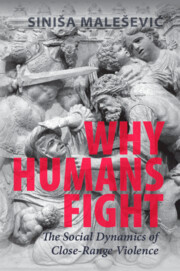Book contents
- Why Humans Fight
- Why Humans Fight
- Copyright page
- Dedication
- Contents
- Acknowledgements
- Introduction
- 1 The Body and the Mind
- 2 Profiting from Fighting
- 3 Clashing Beliefs
- 4 Enforced Fighting
- 5 Fighting for Others
- 6 Avoiding Violence
- 7 Social Pugnacity in the Combat Zone
- 8 Organisational Power and Social Cohesion on the Battlefield
- 9 Emotions and Close-Range Fighting
- 10 Killing in War
- 11 The Future of Close-Range Violence
- Conclusion
- Appendix Methodology and Data Collection
- References
- Index
11 - The Future of Close-Range Violence
Published online by Cambridge University Press: 29 September 2022
- Why Humans Fight
- Why Humans Fight
- Copyright page
- Dedication
- Contents
- Acknowledgements
- Introduction
- 1 The Body and the Mind
- 2 Profiting from Fighting
- 3 Clashing Beliefs
- 4 Enforced Fighting
- 5 Fighting for Others
- 6 Avoiding Violence
- 7 Social Pugnacity in the Combat Zone
- 8 Organisational Power and Social Cohesion on the Battlefield
- 9 Emotions and Close-Range Fighting
- 10 Killing in War
- 11 The Future of Close-Range Violence
- Conclusion
- Appendix Methodology and Data Collection
- References
- Index
Summary
The overwhelming majority of popular science fiction TV shows, films, and novels depicting the world of the future do so in very similar, mostly post-apocalyptic, ways: with the collapse of governance structures human beings automatically turn to violence. The central assumption that underpins these depictions of the future is that the disintegration of law and order would inevitably lead to vicious and bloody struggle for survival. In many respects these fictional narratives draw upon and reproduce the ideas that have dominated political and military thought for centuries. From Machiavelli and Hobbes to the contemporary neo-realists and cognitive evolutionary psychologists, violence and war are perceived to be the natural state of individuals, societies, and states. In this chapter I challenge these Hobbesian visions of violent futures and argue that the dynamics of social pugnacity is context dependent and highly variable. By focusing on the organisational, ideological, and micro-interactional processes that make fighting possible I envisage different possibilities and trajectories of close-range violence in the future.
- Type
- Chapter
- Information
- Why Humans FightThe Social Dynamics of Close-Range Violence, pp. 307 - 325Publisher: Cambridge University PressPrint publication year: 2022

